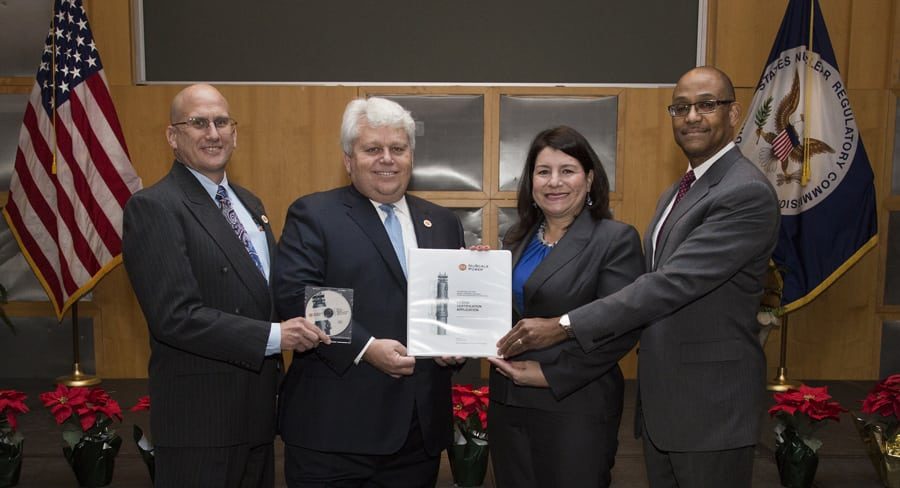
Home » NuScale Power’s small reactor project gains traction
NuScale Power’s small reactor project gains traction

July 16, 2018
A first-of-its-kind reactor complex in Idaho Falls will be operated by Energy Northwest — probably in the middle of the next decade.
In late spring, the U.S. Nuclear Regulatory Commission finished the initial phase of reviewing the first small modular reactor design to be submitted to the agency.
This design application for a small modular reactor by NuScale Power is the only one submitted so far to the NRC. The NRC expects to tackle three more phases of reviewing NuScale’s proposed designs in 2019, with two additional reviews to be completed by September 2020. The first review phase began in March 2017.
“That’s a huge deal because Phase 1 is the most intensive phase of the review, taking more hours and effort than the remaining five phases combined,” wrote Jim Conca, a Richland-based science columnist for Forbes magazine.
One aspect of the small modular reactor concept is that a growing site of small prefabricated reactors can be phased in more cost efficiently than building one huge 1,000-megawatt reactor. NuScale’s design would allow up to twelve 50-megawatt modular reactors to be hooked together into one main unit capable of producing 600 megawatts of power.
Also, only one 50-megawatt reactor will have to be shut down at a time for refueling while 11 small reactors remain online, instead of closing down the entire reactor complex, said Brent Ridge, Energy Northwest’s vice president for corporate services and chief financial officer.
With the financial backing of Fluor Corp., NuScale Power of Corvallis, Oregon, hopes to build the first actual small modular reactor complex at the Idaho National Laboratory, or INL, by the middle of the 2020s.
NuScale intends to provide its first small modular reactors to the Utah Association Municipal Power Systems, a consortium of 44 utilities in Oregon, California, Nevada, Arizona, New Mexico, Utah, Wyoming and Idaho.
The intended INL complex has a cost estimate of $2.9 billion with an estimated three years to build. It would be operated by Energy Northwest, which already runs the Columbia Generating Station reactor north of Richland.
“We speak the same language. We have the same value set of local controls to local agencies,” said Energy Northwest spokesman Mike Paoli.
A small modular reactor is a prefabricated reactor of 300 megawatts or less. The concept is that all the major components would be built at a manufacturing site and then shipped to the reactor location for assembly.
NuScale has not yet selected its manufacturing partner or its central manufacturing site, said NuScale spokeswoman Mariam Nabizad.
The Tri-City Development Council has been keeping close tabs on NuScale’s efforts, hoping a combination of the Tri-Cities’ nuclear skills and never-used, partly-built Washington Public Power Supply System reactor infrastructure will provide an attractive manufacturing site.
“We think we still have a shot at it,” said TRIDEC President Carl Adrian.
The need for additional electricity in the Northwest is expected to surface about 2030.
Meanwhile, Energy Northwest — which has the only power reactor in the Northwest — is looking to gain experience in operating this new type of reactor, Paoli said.
The NuScale design is simpler and has less working parts than Energy Northwest’s 1,100-megawatt reactor. NuScale has set up a simulator of its control room and plans to set up another in Richland. Energy Northwest expects to begin training small modular reactor crews about two years prior to the Idaho site going online, Ridge said.
The small modular reactor digital controls are designed differently from the more-analog one at the Columbia Generating Station.
NuScale’s design is also going through a new and different licensing review process at the NRC. Ridge said a question yet to be answered by the NRC is whether a 12-small-reactor complex will need one crew or 12 crews operating it — one for each 50-megawatt reactor.
It is too soon to tell if small modular reactors will become a trend in building new reactors across the nation, said Matthew Wald, spokesman for the Nuclear Energy Institute.
“It’s hard to predict the future of energy,” he said.
An example of this difficulty is Westinghouse Electric Co., which had been trying to develop small modular reactors. But those went on a back burner when Westinghouse filed for Chapter 11 bankruptcy protection in March 2017, largely prompted by cost overruns and delays on building four full-size reactors at two sites in Georgia and South Carolina. The two 1,200-megawatt Georgia reactors saw their construction budget grow from $14 billion to $20 billion — more than six times the cost of NuScale’s project, while producing only four times the electricity.
In January, Brookfield Business Partners LP agreed to buy Westinghouse for roughly $4.6 billion. In March, a federal bankruptcy court judge approved Westinghouse’s plan to reorganize.
Somewhere between NuScale and Westinghouse in designing a small modular reactor is a joint venture by Holtec International and GE Hitachi Nuclear Energy to develop a 160-megawatt reactor. This design has not yet been submitted to the NRC. GE Hitachi also has joined with Advanced Reactor Concepts to develop a small modular reactor in Canada, which is still in the design stage.
Utah Associated Municipal Power Systems wants to host the small modular reactor facility because it plans to shut down its coal-fired plants in the mid-2020s. It wants to spread the replacement power among both renewable and non-renewable sources, and small modular reactors helps it do so, said UAMPS spokesman LaVar Webb. Also, UAMPS likes the flexibility of adding a few modules at a time, he said.
Meanwhile, the NRC has received the preliminary paperwork on another site besides INL to host a small modular complex. The Tennessee Valley Authority, or TVA, has applied for an NRC “early site permit” review of its Clinch River reactor site to accommodate a group of small modular reactors that could grow up to 800 megawatts in power production. This application looks solely at the site without accounting to the reactors’ design.
The TVA has not yet picked a specific design of a small modular reactor, and it is still researching its future power needs, said authority spokesman Jim Hopson.
Three small modular reactor complexes — using three different designs — already exist in China, India and Siberia, according to the World Nuclear Association in 2017. Five more are under construction in Russia, China and Argentina.
The association lists another 10 projects worldwide, including NuScale’s, that are far into their development stages in the United States, Canada, Russia, China and South Korea. Another 22 projects worldwide, including Westinghouse’s, are either in their infancies or have been significantly sidetracked, according to the association.
“While we maintain priority on the work needed to support our first domestic deployment in Idaho, there is substantial international interest in small modular reactors and in the NuScale design specifically. We are actively pursuing this huge market opportunity including those in the (United Kingdom), Middle East, Eastern Europe, and Southeast Asia. … This interest has increased considerably in the past year and is reflective of an overall international (small modular reactor) market size estimated to be as high as $550 billion through 2035,” said NuScale’s Nabizad in an email.
Wald of the Nuclear Energy Institute said small modular reactors received a February boost from Congress when it extended production tax credits for nuclear power plants. The credits originally came from the 2005 Energy Act to help troubled reactor projects such as Westinghouse’s. But that credit was supposed to sunset in 2020 — a deadline that none of Westinghouse’s delayed reactors are on schedule to make.
The new law allows the tax production credits to be used for the first 6,000 megawatts worth of reactors to go online after Jan. 1, 2021, a scenario that is expected to include NuScale’s Idaho project.
Local News Energy
KEYWORDS july 2018





